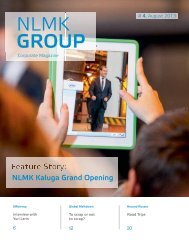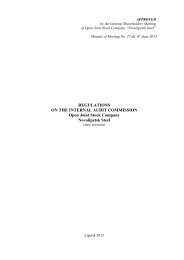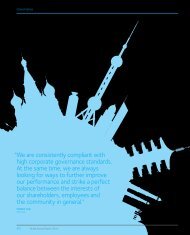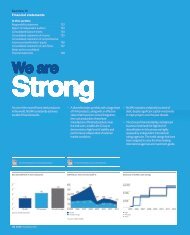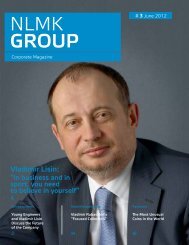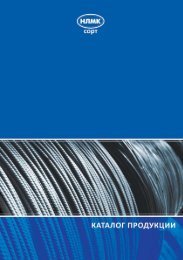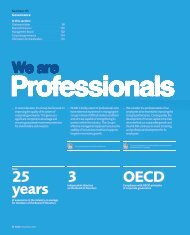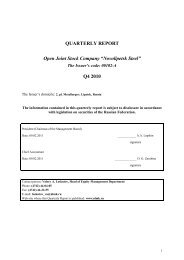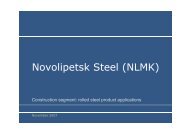NLMK Group
NLMK Group
NLMK Group
You also want an ePaper? Increase the reach of your titles
YUMPU automatically turns print PDFs into web optimized ePapers that Google loves.
Panorama GREAT INVENTORS<br />
35<br />
to join a commission responsible<br />
for the introduction of the electric<br />
telegraph. On December 14, 1846,<br />
the day following his 30th birthday,<br />
Siemens wrote to a relative: “I<br />
have almost decided to pursue a<br />
career in telegraphy irrespective<br />
of whether it can be combined<br />
with my military service. In time<br />
telegraphy will become a separate<br />
important part of technology, and<br />
I see my calling in becoming the<br />
organizing force of this.” Within a<br />
period of ten months Siemens and<br />
Halske received several lucrative<br />
orders and on October 1, 1847 they<br />
founded the Telegraphenbauanstalt<br />
Siemens & Halske company.<br />
In 1849 Werner Siemens retired<br />
from military service and focused<br />
on his inventions. During the<br />
same year Siemens & Halske built<br />
Europe’s first electric telegraph<br />
line between Berlin and Frankfurt.<br />
After their initial success the<br />
company was flooded with orders,<br />
and even some imperfections in<br />
the early projects, caused by the<br />
authorities’ reluctance to provide<br />
Siemens & Halske with adequate<br />
funding required for procuring<br />
high-quality materials, could not<br />
prevent it from flourishing. Also,<br />
very soon the company received<br />
significant assistance from overseas.<br />
One of Werner’s younger<br />
brothers, Karl, unexpectedly<br />
secured a contract in Russia to<br />
build a telegraph line between<br />
St. Petersburg and Moscow. The<br />
job was finished in 1851 and<br />
became the first for Siemens in<br />
the huge Russian market. During<br />
the Crimean War on the Black<br />
Sea communications lines were<br />
installed to Sevastopol, allowing<br />
telegraph connections for large<br />
cities like Kiev and Odessa. New<br />
contracts from the Russian<br />
Empire continued to arrive over<br />
the next 50 years, and Russia<br />
became a key partner for Siemens<br />
& Halske. Russian authorities<br />
again contracted the company<br />
when it was required to lay a cable<br />
under water, across the Baltic Sea,<br />
another first in human history.<br />
Several years later the Siemenses<br />
did Russia a favor by persuading<br />
European countries to install<br />
the line between London and<br />
Calcutta via the Russian Caucasus,<br />
bypassing Turkey.<br />
Building telegraph lines was<br />
the main specialization, but not<br />
the only one for Siemens & Halske.<br />
Siemens himself, an explorer by<br />
nature, would be reluctant to focus<br />
on just one thing. After handing<br />
the telegraph business to his<br />
commercially savvy brothers he<br />
started designing other things.<br />
Just before he turned 50 years<br />
old Siemens began work on the<br />
design of a device that would<br />
generate current without relying<br />
on batteries, a dynamo machine.<br />
This produced the direct current<br />
generator which spurred on a<br />
revolution in various spheres of<br />
human life. The Siemens dynamo<br />
machine allowed miners to utilize<br />
power tools, electric cars and<br />
electric trains for transporting<br />
ore. Most importantly, the dynamo<br />
machine made it possible to<br />
develop electric transportation<br />
in general. Already in 1879 at<br />
the World Trade Fair Siemens<br />
demonstrated his electric railroad,<br />
which carried visitors between<br />
pavilions. Two years later his<br />
company built the first electric<br />
streetcar line in a Berlin suburb.<br />
Over time construction of electric<br />
Map of telegraph<br />
lines built by Siemens<br />
& Halske in the Russian<br />
Empire



